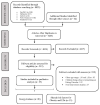Impact of Strategies for Preventing Obesity and Risk Factors for Eating Disorders among Adolescents: A Systematic Review
- PMID: 33066501
- PMCID: PMC7602154
- DOI: 10.3390/nu12103134
Impact of Strategies for Preventing Obesity and Risk Factors for Eating Disorders among Adolescents: A Systematic Review
Abstract
An effective behavior change program is the first line of prevention for youth obesity. However, effectiveness in prevention of adolescent obesity requires several approaches, with special attention paid to disordered eating behaviors and psychological support, among other environmental factors. The aim of this systematic review is to compare the impact of two types of obesity prevention programs, inclusive of behavior change components, on weight outcomes. "Energy-balance" studies are aimed at reducing calories from high-energy sources and increasing physical activity (PA) levels, while "shared risk factors for obesity and eating disorders" focus on reducing disordered eating behaviors to promote a positive food and eating relationship. A systematic search of ProQuest, PubMed, PsycInfo, SciELO, and Web of Science identified 8825 articles. Thirty-five studies were included in the review, of which 20 regarded "energy-balance" and 15 "shared risk factors for obesity and eating disorders". "Energy-balance" studies were unable to support maintenance weight status, diet, and PA. "Shared risk factors for obesity and eating disorders" programs also did not result in significant differences in weight status over time. However, the majority of "shared risk factors for obesity and eating disorders" studies demonstrated reduced body dissatisfaction, dieting, and weight-control behaviors. Research is needed to examine how a shared risk factor approach can address both obesity and eating disorders.
Keywords: adolescents; eating disorders; obesity; prevention programs; systematic review.
Conflict of interest statement
The authors declare no conflict of interest.
Figures


Similar articles
-
Integrating messages from the eating disorders field into obesity prevention.Adolesc Med State Art Rev. 2012 Dec;23(3):529-43. Adolesc Med State Art Rev. 2012. PMID: 23437686 Review.
-
Overlap in Eating Disorders and Obesity in Adolescence.Curr Diab Rep. 2015 Oct;15(10):78. doi: 10.1007/s11892-015-0645-y. Curr Diab Rep. 2015. PMID: 26303593 Review.
-
Weight-related teasing and non-normative eating behaviors as predictors of weight loss maintenance. A longitudinal mediation analysis.Appetite. 2016 Jul 1;102:25-31. doi: 10.1016/j.appet.2016.02.017. Epub 2016 Feb 11. Appetite. 2016. PMID: 26877218
-
Weight stigma and eating behaviours in elementary school children: A prospective population-based study.Appetite. 2016 Jul 1;102:51-9. doi: 10.1016/j.appet.2016.02.005. Epub 2016 Feb 4. Appetite. 2016. PMID: 26851574
-
Obesity and Eating Disorders in Children and Adolescents: The Bidirectional Link.Nutrients. 2021 Nov 29;13(12):4321. doi: 10.3390/nu13124321. Nutrients. 2021. PMID: 34959873 Free PMC article. Review.
Cited by
-
Health literacy and obesity: A systematic scoping review.Obes Rev. 2025 Jun;26(6):e13904. doi: 10.1111/obr.13904. Epub 2025 Feb 11. Obes Rev. 2025. PMID: 39933504 Free PMC article.
-
Contribution of food groups to energy, grams and nutrients-to-limit: the Latin American Study of Nutrition and Health/Estudio Latino Americano de Nutrición y Salud (ELANS).Public Health Nutr. 2021 Jun;24(9):2424-2436. doi: 10.1017/S136898002100152X. Epub 2021 Apr 12. Public Health Nutr. 2021. PMID: 33843560 Free PMC article.
-
Validation of the Childhood Family Mealtime Questionnaire in Mexican Adolescents with Obesity and Their Caregivers.Nutrients. 2023 Nov 28;15(23):4937. doi: 10.3390/nu15234937. Nutrients. 2023. PMID: 38068795 Free PMC article.
-
Gestational diabetes mellitus complicated with depression in pregnant women: a biopsychosocial analysis and intervention strategies.BMC Pregnancy Childbirth. 2025 Aug 6;25(1):818. doi: 10.1186/s12884-025-07916-2. BMC Pregnancy Childbirth. 2025. PMID: 40770744 Free PMC article.
-
The Role of Problematic Smartphone Uses and Psychological Distress in the Relationship Between Sleep Quality and Disordered Eating Behaviors Among Chinese College Students.Front Psychiatry. 2021 Dec 13;12:793506. doi: 10.3389/fpsyt.2021.793506. eCollection 2021. Front Psychiatry. 2021. PMID: 34966312 Free PMC article.
References
-
- NCD Risk Factor Collaboration (NCD-RisC) Worldwide trends in body-mass index, underweight, overweight, and obesity from 1975 to 2016: A pooled analysis of 2416 population-based measurement studies in 128.9 million children, adolescents, and adults. Lancet. 2017;390:2627–2642. doi: 10.1016/S0140-6736(17)32129-3. - DOI - PMC - PubMed
Publication types
MeSH terms
Grants and funding
LinkOut - more resources
Full Text Sources
Medical

